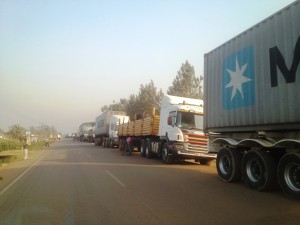My young friend Giovanni came back from a visit to East Africa last week. As part of the trip, he traveled by car from Uganda to Kenya. This involves crossing the Malaba border where trucks can wait anywhere from 2 days to 2 weeks. But the driver was an expert at crossing this border, so they only had to wait about 3 hours.
Comparatively, the time it takes to trade across East Africa borders is not really, all that long, and East African countries are taking important measures to improve things further.

Clearing customs and going through inspections is only one of the steps involved in export and import trading. Other steps include:
- obtaining, filling out, and submitting the necessary documents;
- inland transport and handling (see related post on intra-African trade and transportation);
- potentially, port and terminal handling.
In addition to the time physically needed to carry out these steps, there is waiting time to consider. This is what the World Bank does to estimate the average time required to export and import across 189 countries. Below is the total length of time required for East African countries (estimated in June 2014):
| Country |
Days to export |
Days to import |
| Tanzania |
18 |
26 |
| Kenya |
26 |
26 |
| Rwanda |
26 |
27 |
| Uganda |
28 |
31 |
|
Burundi |
32 |
43 |
Here are some reference points for other countries:
- Minimum time to export: 6 days (Denmark, Estonia, Hong Kong (China), Singapore, USA)
- Minimum time to import: 4 days (Singapore)
- Maximum time to export: 86 days (Afghanistan)
- Maximum time to import: 91 days (Afghanistan)
Things have improved in recent years. A variety of reforms have been implemented to speed up wating times. For instance (and as reported by the World Bank):
- Tanzania has implemented the Pre-Arrival Declaration (PAD) system and electronic submission of customs declarations;
- Kenya has implemented an electronic cargo tracking system and linked this system to the Kenya Revenue Authority’s electronic data interchange system for customs clearance.
- Rwanda has made administrative changes such as expanded operating hours and enhanced border cooperation and it has eliminated some documentation requirements; extended customs opening hours and it has implemented and improved electronic data interchange and risk-based inspection systems and made improvements in the transport sector.
- Uganda has reduced the time required for trading across borders through expanded operating hours at the port of Mombasa and made improvements to customs processes and border cooperation.
- Burundi has scaled up the use of electronic data interchange systems, introduced a more efficient system for monitoring goods going through transit countries and improved border coordination with neighboring transit countries.
Have you (or your goods) ever crossed these borders?

